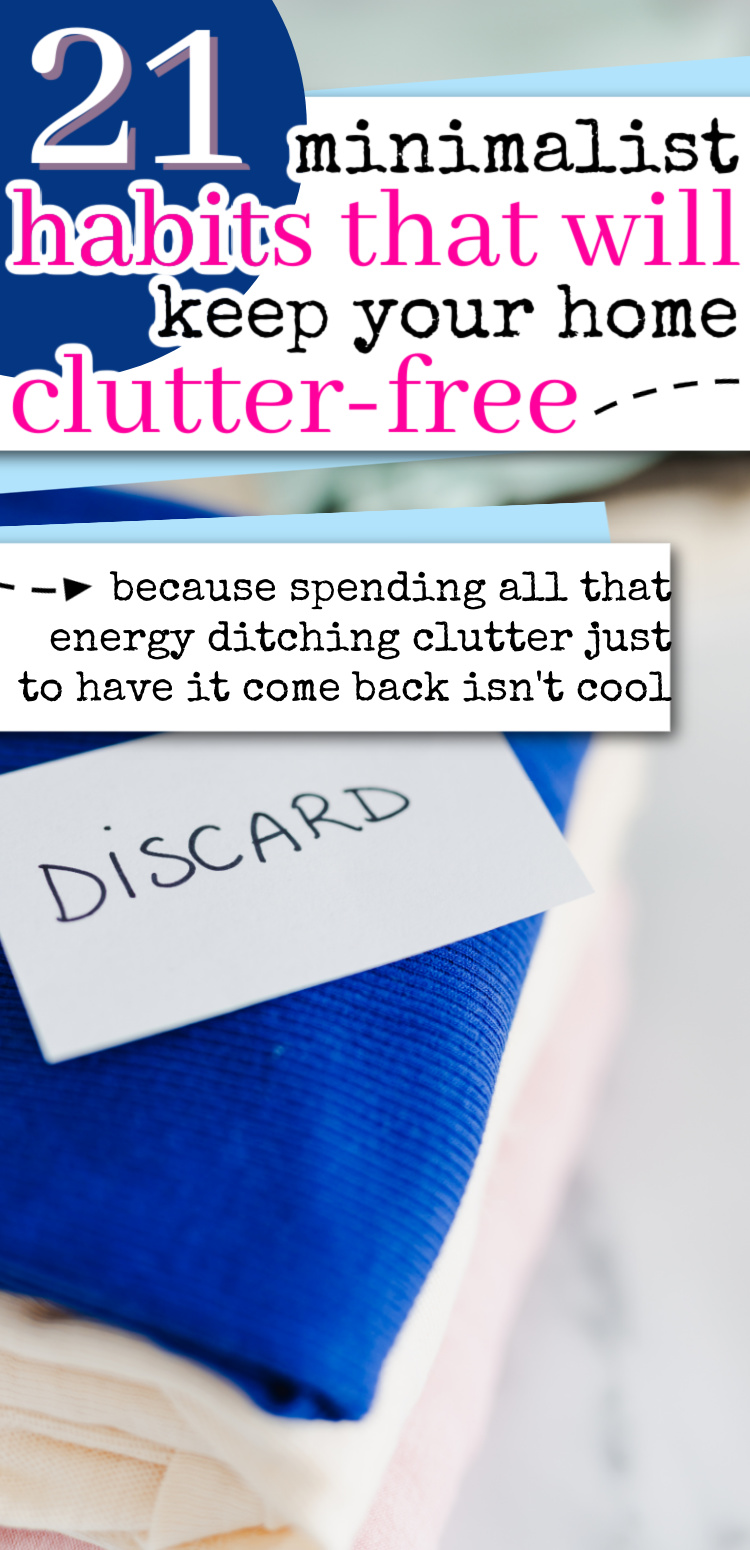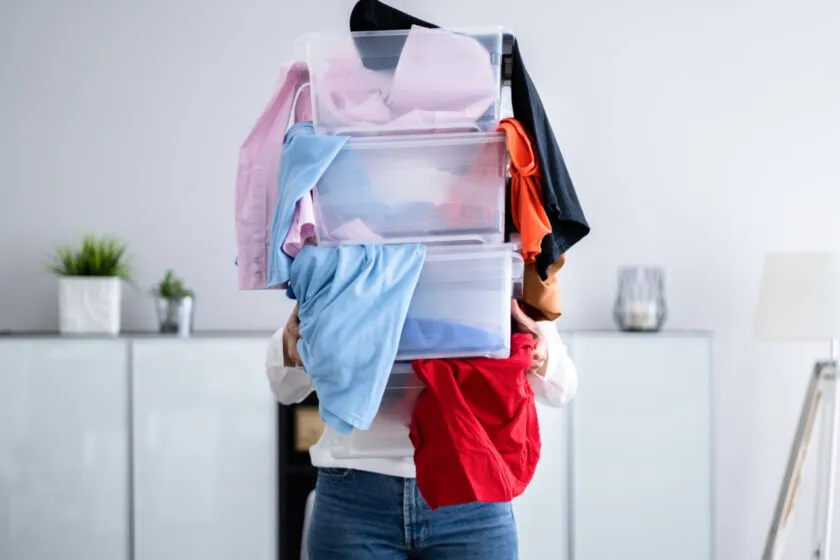Inside: Wondering how minimalists keep their homes clutter-free? They adopt minimalist habits that keep the clutter permanently at bay, protecting the havens they’ve worked so hard to create.
The kind, generous stranger held out the garbage bag full of clothes to me with hopeful eyes.
She’d glimpsed my 3-year-old sitting in the car, “I see you have a little girl? Could you use this bag of hand-me-downs?”
We met by chance today at the clothing donation bins. Where we live, thrift stores usually decline donations after only a few months of receiving them, with no space to take more unwanted stuff.
As we both tossed plastic bags full of clothing donations into the cold metal bins, we commiserated on the lack of decluttering options in our area.
She lamented needing to use the bins at all, “I hate having to drop the clothes here, but we don’t have anyone to hand them down to.”
Seeing my daughter made her eyes light up because she thought I might be able to use the clothes.
Her offer was so kind and thoughtful, I almost caved.
Almost.
“Thanks so much, but we don’t need any clothes at the moment,” I replied, smiling to soften the blow just a little. I hated to see her face fall, but I also knew exactly what would have happened if I’d said “yes”.
You Might Also Like: 7 Best Books on Minimalism & Simple Living (I’ve Read 90% of Them)

21 Minimalist Habits for a Clutter-Free Home
This post probably contains affiliate links, which means I may earn a commission if you make a purchase through those links. As an Amazon Associate, I earn from qualifying purchases. You can find our full disclosure HERE.
It’s taken me several years to develop the habits I need to maintain a clutter-free home.
Declining free stuff is one of those habits, especially when it comes in bags of unseen, unknown items from random, good-hearted strangers.
Unless we truly need something, my default answer is consistently “thanks, but no thanks.”
As I thought about that habit this week, and habits in general (because: New Year’s), I realized that I have quite a few of these “minimalist habits”. I do them without even thinking, and they keep our home mostly clutter-free.
After you declutter your home, adopting these minimalist habits can help you keep it clutter-free for good. I hope you find them as helpful as I have!
Related: 17 Tiny Habits for Slow and Steady Wins This Year
1. Have a happiness list.
Creating a “what makes me happy” list is by far, the most effective deterrent to buying clutter (and wasting money/time/energy) I’ve ever come across.
Get out a pen and paper, write down what makes you the happiest. It could be spending time with family, traveling, that first cup of perfect morning coffee, wearing amazing outfits.
There’s no room for judgement when you make the list. If it makes you really, truly happy, write it down.
Use this list as a guide for evaluating future purchases.
Example: If what truly makes you happy is traveling, then why are you spending money upgrading your living room with $2000 furniture or dropping $300 at Target every weekend on random stuff (that you’ll eventually declutter)?
You Might Also Like: An Invitation to Life Without Goals (& New Year’s Eve Alternatives)
2. Stick to the container principle.
The container principle, made popular by Dana White from A Slob Comes Clean, is pretty basic: you decide how much space to dedicate to each type of item. It could be a bin, a shelf, or square footage.
When you fill up that “container, you’re done. If you want to bring new things in, you need to remove something from that container.
If your bookshelves are full, you’re done buying books, unless you’re prepared to give some away.
If your drawers are full, you’re done buying clothes, until you’ve decluttered your clothes.
3. One in one out.
We operate more or less by the “one in, one out” rule. There’s a little leeway to add without subtracting (particularly when it comes to, ahem, plants or books, my two major vices).
But mostly, if we want to bring something new in, we’ve got to get rid of something.
For example, I know I have enough clothes, but some of them desperately need replacing. I just added a long sleeve shirt, so I threw away a threadbare, pretty sure I’ve had it 15 years, Old Navy shirt.
If want to bring in new toys, I either put some away to rotate in later, or I declutter something.
Once you’ve decluttered like a boss and brought your stuff down to your desired stuff threshold, enforce the “one in one out” rule to keep it clutter-free.
4. Deal with mail immediately.
O.k., I’m not one of those minimalists who preaches the “one touch” rule, but I will preach the “one touch mail” rule.
If you don’t deal with mail as soon as you bring it home, it piles up. And sadly, it’s 75% junk.
Sort through mail right after you bring in home.
Recycle the junk. Pay the bills, or put them in a place where you will see them and remember to pay them.
Try on the clothes. Start the return. Put away packages.
Create a folder for “to deal with later” items. A family command center can be a great place to store this folder.
Related: Got paper clutter coming out your ears? Learn how to reduce it.
5. Wait 72 hours on purchases above a certain dollar amount.
Decide what your dollar limit is. Above $25? $50?
Personally, I consider anything above $50 a major purchase, and I try to wait at least 72 hours before I click “buy” to determine whether I really want or need whatever it is.
Sometimes, just clicking “add to cart” gives you that dopamine hit and gets the spending bug out of your system.
You come back to it 72 hours later and wonder what the heck you were thinking.
Related: 11 Money Lessons Kids Desperately Need (That Schools Don’t Teach)
6. No impulse buys.
My last impulse buy was a special issue of TIME magazine on work. I bought it several months ago.
You know what’s still hanging around my house, half read, yet I’m for whatever reason incapable of throwing away? That dang magazine.
I realized a couple years ago that I don’t like having magazines in my home. I’ll scan them at the library or doctor’s office, but mostly I’m just not a magazine person.
This was clearly an impulse buy for me. And I’m paying for it.
Any time I have an impulse to buy something not on my list, I remind myself that if I didn’t intend to buy it, I don’t need it or truly want it, either.
(Exceptions include items you forgot to put on the list, but seeing them in the store reminds you that you need them!)
You Might Also Like: 11 Minimalist Budgeting Tips & Tricks (Stress Less, Save More)
7. Invest in quality when you can.
When I started this website, we were living paycheck to paycheck in an expensive city, with a fairly low income for a family our size. So I absolutely get that this isn’t always possible.
But as we’ve been able, investing in higher quality items that last longer has become a priority, mostly for the adults who don’t grow and change quite as much as the kiddos do.
For example, I’m slowly replacing my long sleeve winter shirts with Woolx shirts like THIS one, just one a year. I will likely need less of them because they can be worn several times before washing.
Only caveat? Expensive doesn’t always mean high quality. The unfortunate reality of living in our modern world.
Related: My Comfy Minimalist Winter Wardrobe (Perfect for Homebodies!)
8. Declutter regularly.
Decluttering isn’t a one and done thing. It usually needs to be done seasonally.
I frequently put items into our “wait and see” bin. But making decisions about those items only happens a few times a year.
I try to declutter (as in get that stuff out of the house) in November before the insanity that is Christmas hits, and then again right around New Year’s. I also declutter in the summer, when I’m putting away winter items and pulling out swim gear.
Pick a few times a year that make sense to you.
9. Avoid single-use items like the plague.
Zesters can only….zest. But a grater can do the same thing, plus five more.
Apple corers can only cut apples. A good knife can do the same thing.
Stick to multi-purpose items as much as possible.
Related: 7 Duplicates I’ll Never Declutter (Even Though I’m a Minimalist)
10. Shop your house first.
We just moved our living room around again. I thought I needed another chair for a very empty space.
But thankfully, I remembered to shop my house first.
I played ring around the rosy with our various armchairs, and boom. No new chair needed.
I’ve done the same with bins/baskets, lamps and clothes. Shop your house first!
11. Use pick-up or online ordering.
Going into the store like Target is a major temptation for me. Thankfully it’s 30 miles away, so I only go a few times a year.
I’m far more susceptible to impulse buys for myself or my 3-year-old (that girl LOVES to shop!) when I set foot in a store.
I try to do pick-up or order online whenever possible, although I am trying to get better at grouping my purchases to reduce carbon emissions, instead of buying an item or two every few days.
12. Choose a capsule wardrobe.
Downsizing my closet to contain only things I use and love was one of my best decisions.
I recently pared down even further into a daily uniform.
I still have a few items I wear for special occasions, but usually, I’m wearing my uniform.
You Might Also Like: How to Create a Capsule Wardrobe (& Why You Need One)
13. Decline free items unless you truly need them.
As the opening story suggests, this used to be my Achilles’ heel.
A friend would offer two bags of hand-me-downs, and I’d automatically accept them. I’d accept anything free from anyone, thinking I could use it.
There was a point in my life when I genuinely needed the few items from those hand-me-down bags. I was grateful to accept them, and it was worth taking the time to sort through them and pass along unwanted/unneeded items.
But accepting all those free things came at a cost: my house and closets overflowing with stuff I didn’t really love.
I’ve worked really hard the past couple years to make my default “no” to offers of free stuff, instead of “yes”, and that decision has played a huge part in keeping our house clutter-free.
(I will accept free items offered one by one that we’ve been meaning to replace or purchase ourselves, like binoculars my mom offered us for Christmas.)
14. Unsubscribe from store e-mails.
Shopping season just finished up for the year, and unfortunately, your inbox is probably full of e-mails from brands.
I only stay subscribed to stores I shop at regularly (a scant few).
If I know I’m not buying more Bombas socks, for example, until the annual sale next Black Friday, I don’t need their e-mails in my inbox the rest of the year. Unsubscribed! Done.
15. Give everything a home.
Every item in your house needs to have a home, a place it goes back to when you’re finished using it.
Only when every item has a home can you know whether or not you have too much stuff and need to declutter.
It also makes tidying up so much easier!
You Might Also Like: 21 Little Ways to Make Life Easier (Because Adulting is Hard)
16. Consider borrowing when appropriate.
Borrow books from libraries. Rent tools you rarely use whenever possible. Rent a dress for a once in a lifetime fancy event.
Borrowing from friends, family or neighbors, on the other hand, can get tricky.
I know for certain that sometimes, people who are not minimalists get pretty annoyed when minimalist friends or family start feeling free to borrow what they aren’t willing to own (and store/maintain) those items themselves.
If you never ever bake, but once in five years, your child needs to make a cake for a science experiment, you might borrow a cake pan from a friend or family member. And promptly return it in good condition, of course.
It makes sense not to own something you rarely use, but if you’re wanting to establish an ongoing and frequent “borrow this or that” relationship or culture, be up front about it.
17. Keep surfaces as clear as possible.
Clutter attracts clutter. If you have several items arranged decoratively on the entryway table, family members will feel that much freer to plop stuff down next to those items (items that belong elsewhere).
How clear they are will vary from house to house. For example, my family won’t tolerate me putting the toaster away.
Is the toaster light and easy to put away and take out when you need it? Yes. But they appreciate it sitting on the counter because we use it daily.
Having clear surfaces also makes them that much easier to wipe down regularly.
Related: 7 Minimalist Rules You Don’t Need to Follow (Unless You Want To)
18. Designate a “wait and see” bin.
I borrowed this term from Dawn at The Minimal Mom, but I’ve always had a “wait and see” bin in our house.
This bin is for things I’m not sure we want to part with yet. So I toss it in the bin, labeled with a post-it and the date.
If 3-6 months go by, and I haven’t wanted or needed the item, I know I can sell it, donate it, or throw it away.
19. Decide how to handle donations ahead of time.
Knowing in advance where you are going to bring (or sell) unwanted items is a crucial, but often overlooked step to keeping your home clutter-free.
If you don’t know what to do with your items, they’re probably going to sit in your house.
If they sit in your house, they might very well make their way back INTO your house, one by one.
Do a little research in your area to see where you can bring things like clothes, old linens (animal shelters are great), or toys in good condition.
Side Note: If you wouldn’t buy it at a thrift store, it probably belongs in the trash.
20. Reset the kitchen before bed.
Maybe this isn’t a particularly “minimalist” habit? But it sure is a habit that’s contributed to staying clutter-free.
When the kitchen is cleaned up every night, with the counters clear, we not only have clean dishes in the morning (major plus), but I’m also motivated to deal with any leftover odds and ends on the kitchen and bar counters.
Why? Because the remaining mess is usually my mess. Piles of work papers or mail I haven’t decided what to do with.
So I’ll file the papers, pay the bill, or put away anything else lying around.
You Might Also Like: Minimalist Kitchen Essentials – Just the Basics (According to a Minimalist)
21. Apply minimalism to more than just stuff.
To me, minimalism equals intentionality. When I think about anything I’m doing in life, I ask, “Why am I doing this?”
Why am I folding clothes? Is this really the way I want to spend my time? Nope.
Why am I cleaning all the time? Is that really the way I want to spend my life? Nope.
Do I really want to be attending this event? Is it adding value to my life?
Is this thing I’m doing as part of my morning routine really worthwhile to me? Or just because some guru said it was?
Ask why about just about everything in life to declutter your schedule, not just your stuff.
Related: 10 Things I Stopped Doing That Made Me a Happier Mom

Need to Declutter Before Embracing Minimalism? I Can Help!
If your home isn’t decluttered yet, here are the best articles I could send your way to help you get started:
- The Best Place to Start Decluttering When The Mess Is Overwhelming
- 7 Reasons You Have Difficulty Throwing Things Away (with solutions)
- How to Declutter When You Have No Time & a Tight Budget
- 7 Rules for Decluttering Toys for Quick & Easy Decisions
- Please Don’t Declutter Your Home in a Weekend. Here’s Why.
I hope these help you on your journey to a minimalist home, and a life with less stuff and more time for whatever it is that matters most to you.
Minimalism has changed my entire life for the better. I believe it can do the same for you.
Read Next: The Pros and Cons of Minimalism, According to a Minimalist
Did I miss any minimalist habits? Share a habit you’ve found helpful in maintaining a clutter-free home in the comments!



I found a way to enjoy shopping with my girlfriend, whose budget allows her to buy more.
I take my phone camera, and take photos of the Things I didn’t buy today!”
Can be very expensive something, or, orange Bermuda for my husband. It’s fun, and scratches that itch!
I love this Marilyn! Thanks so much for taking the time to share.
thank you for that whole beautiful written article and it made it very clear and decisive if what I want to do and it’s not too unattainable…. I’ve been decluttering since the first of January have more to do I think I am a lover of stuff but I’m getting rid of that thinking that stinking thinking so thank you!!
Keep going, Gina! You’ve got this. Loving stuff can be o.k.: set limits for yourself based on YOU. Good luck!
Thank you for writing this article so well, it inspires on a minimalist living which we all need to adopt one day. I’m going to print it out for my periodic assessment of decluttering and adopting the habit.
I still struggle to say No to unnecessary gifts from close ones who imagine I need what’s redundant for them, usually sweaters or coats. Cooking pans now multiplied in my home to make a 7 course meal for a family of 4 with two little kids.
Declining free stuff from family and friends is harder, for sure! I try to sandwich my “no” with extra thank you’s for that group. 🙂
WOW, B’Bommer here who’s apparently killing this. Sadly, in 1999, Had to go back to work after a divorce with almost grown kids which meant some relocation & remarriage. I Retired about 5 years ago but my current hubby’s still working . Have been working hard the last few years trying to put things into order again and feeling really good about the way it’s going. Also having to bring my hubby along on this minimalism journey which he is really starting to enjoy. My only comment to those of you out there who are new at this is here are 3 points to keep in mind.. 1.Everybody’s idea of minimalism is different ; 2. move it your own pace And finally, 3. Enjoy the process because you Certainly will in Enjoy the results. 🏖 Kj in Tampa Bay 🥰
Love your three things to keep in mind! Spot on.
Hi, I do think you might have credited Dana K. White with the phrase “the container concept” (as you credited Dawn, the Minimal Mom in another point). I am very familiar with both of the ladies’ work and spotted the omission immediately. Great list of 21 ideas. G Ire
Thank you so much for pointing that out! I definitely want to give credit where credit is due, so I linked to one of her posts on the topic and added a mention.
I don’t put garbage cans in every room. I only put them in the bathroom and the kitchen. that way garbage does not stay in the bedroom or the living area.
Thanks for sharing, Kristine!
My library actually loans baking pans. so you might check to see what local library has to loan besides books and movies
Yes! I love when libraries offer more than just books.